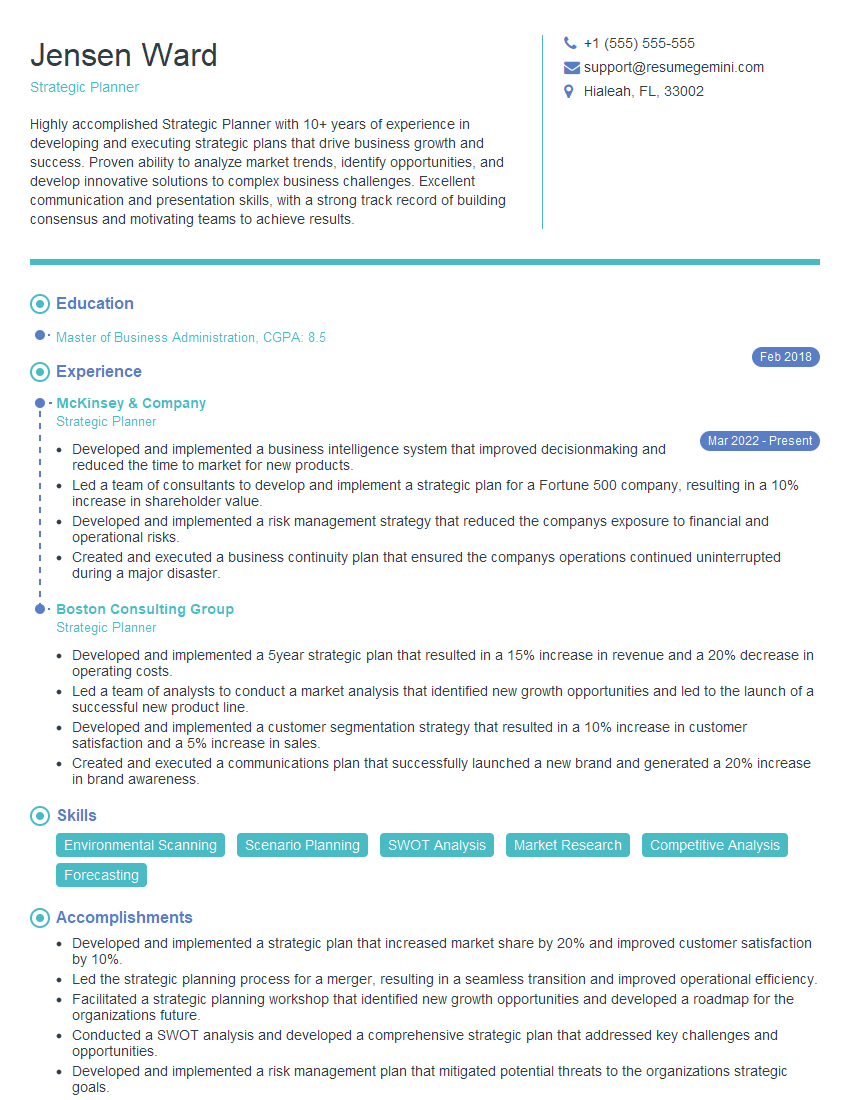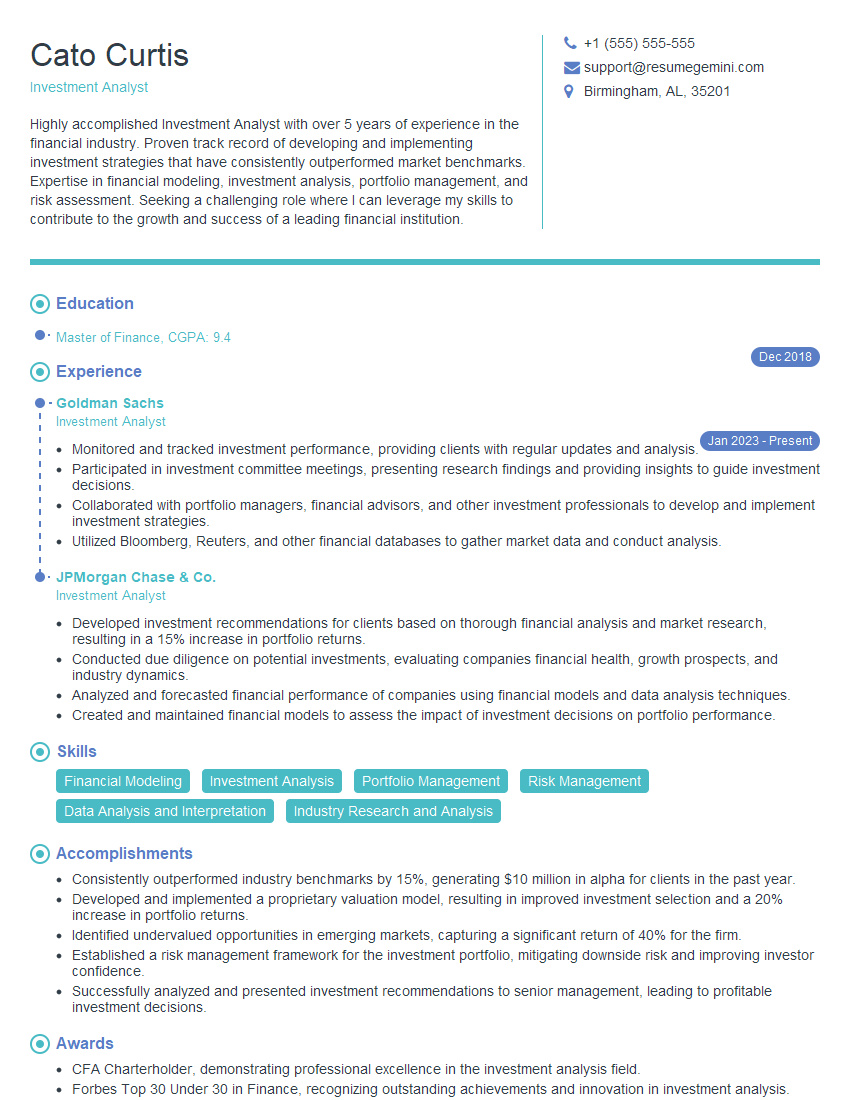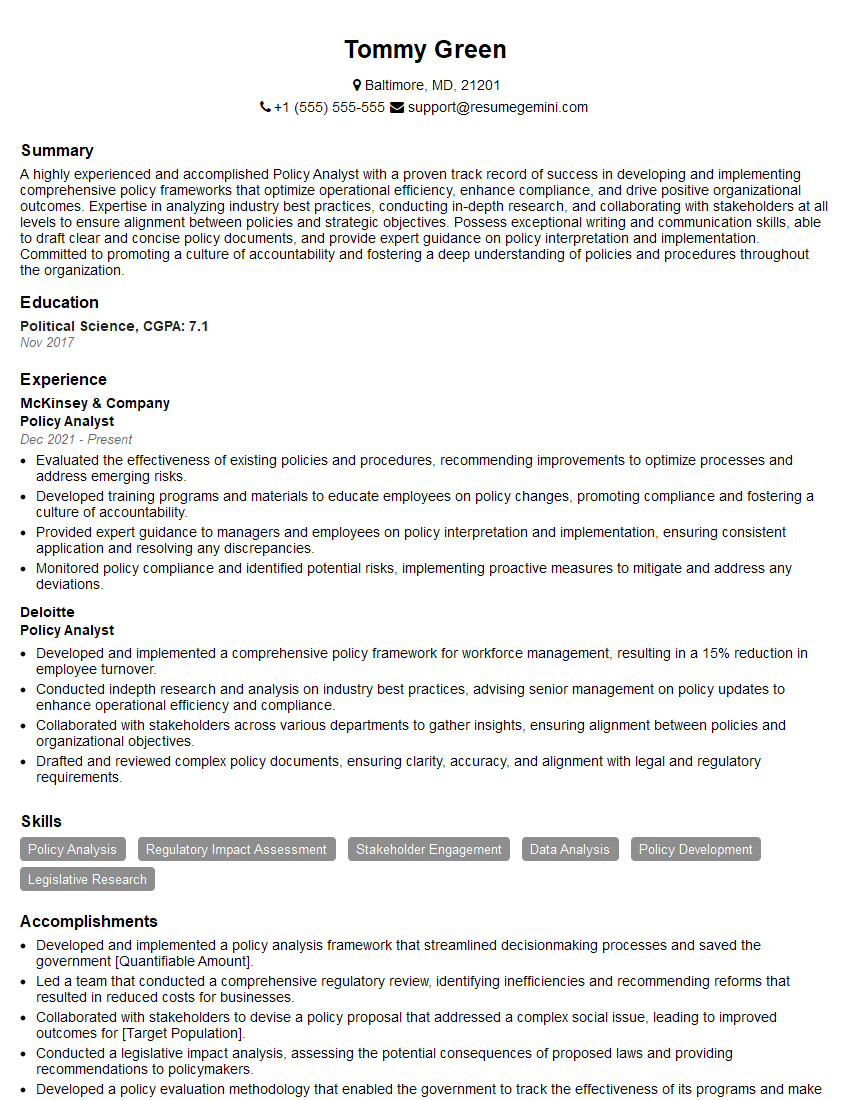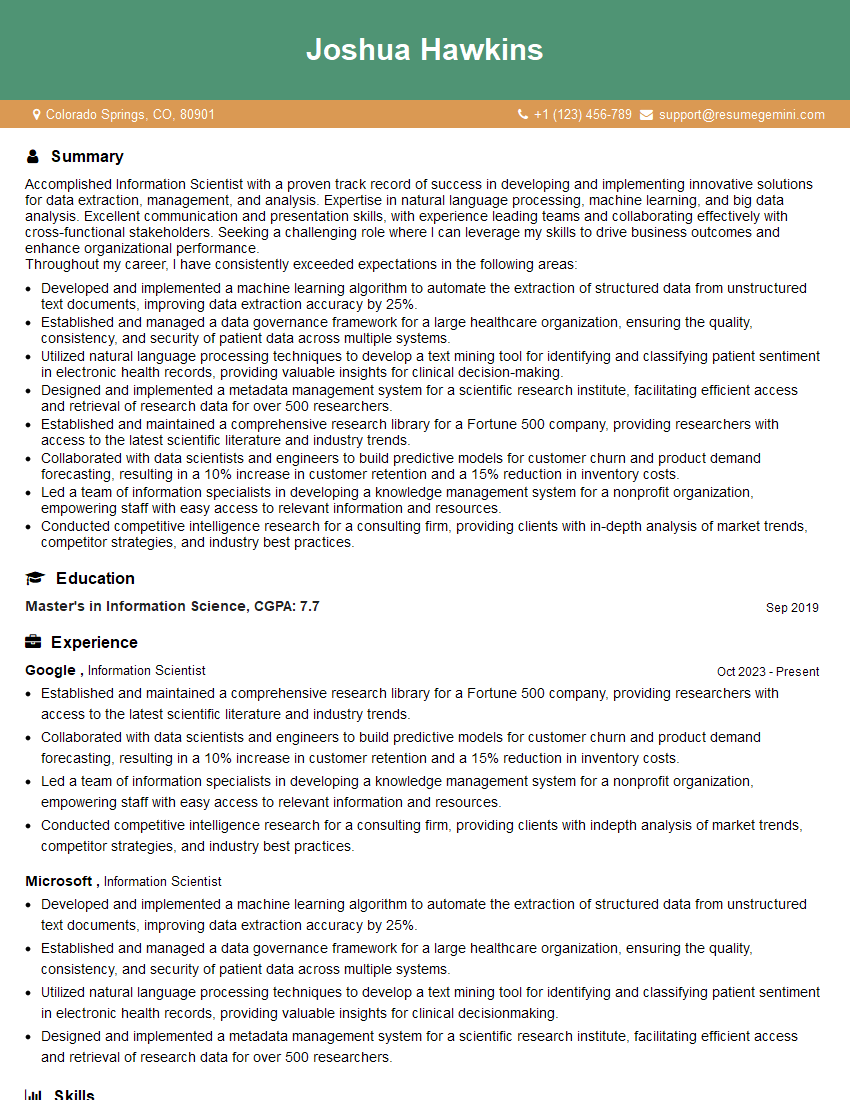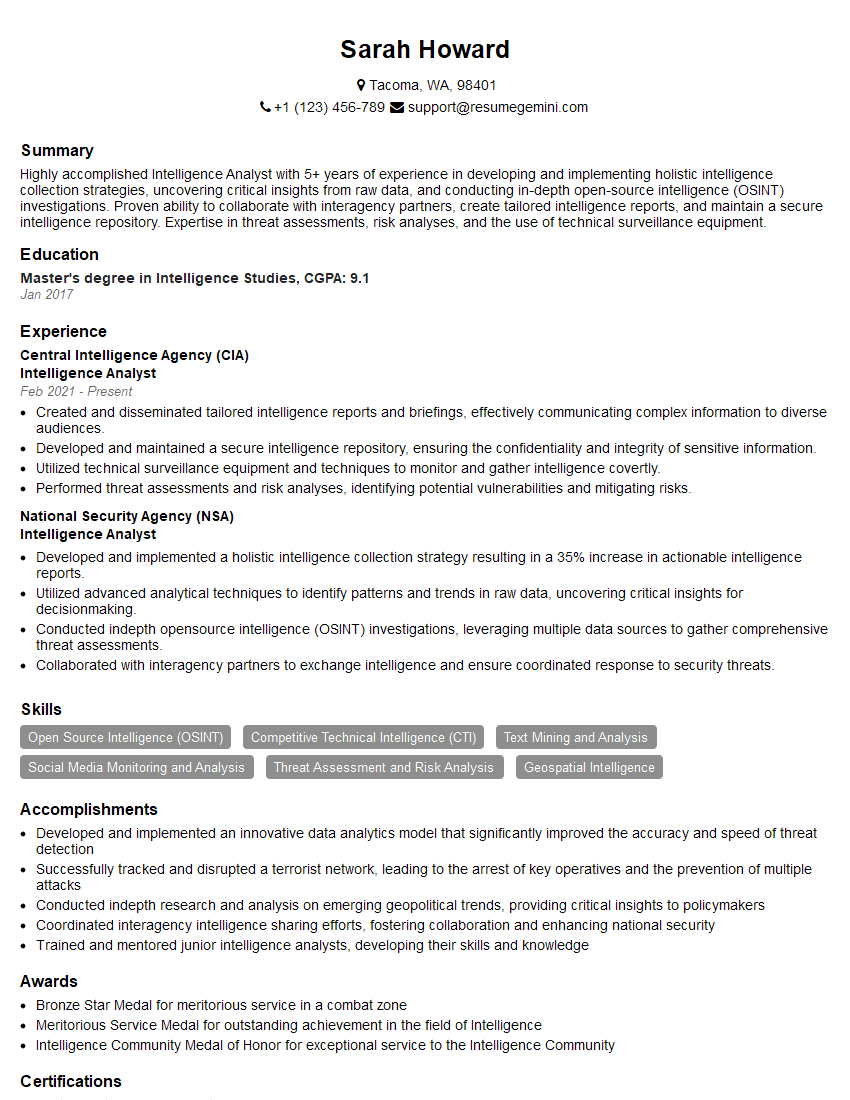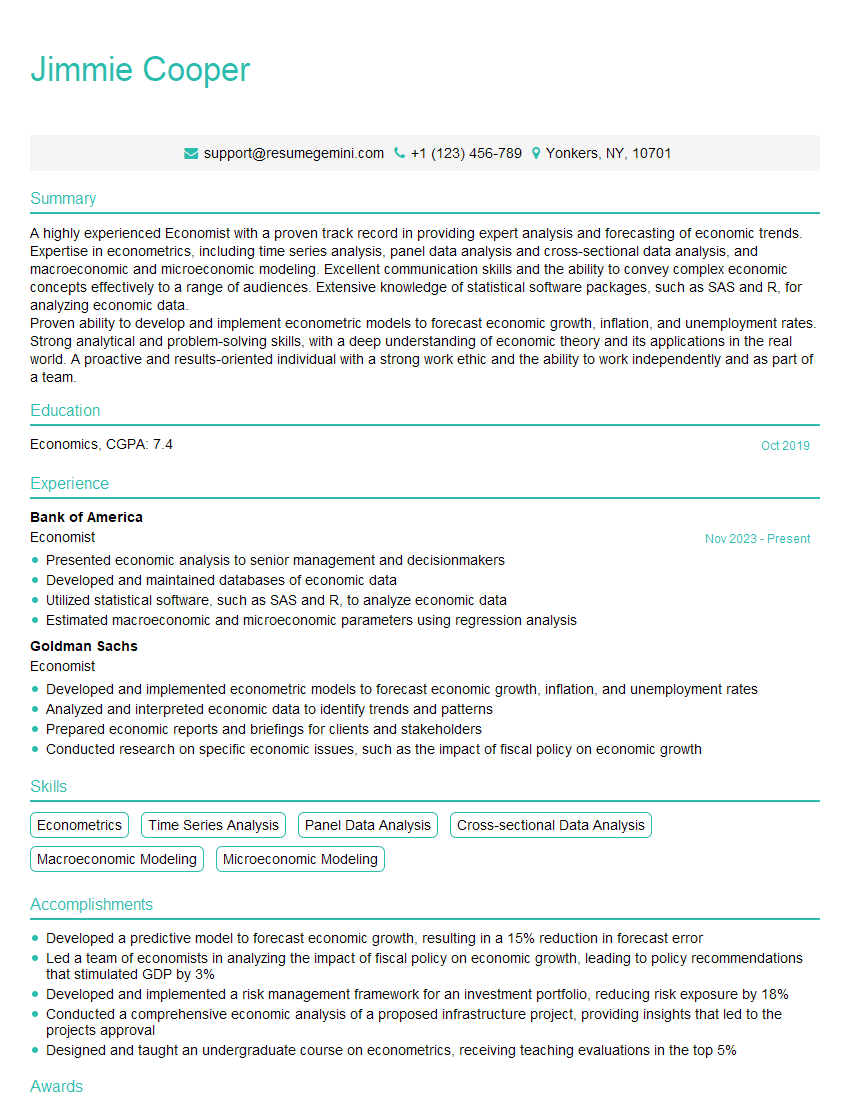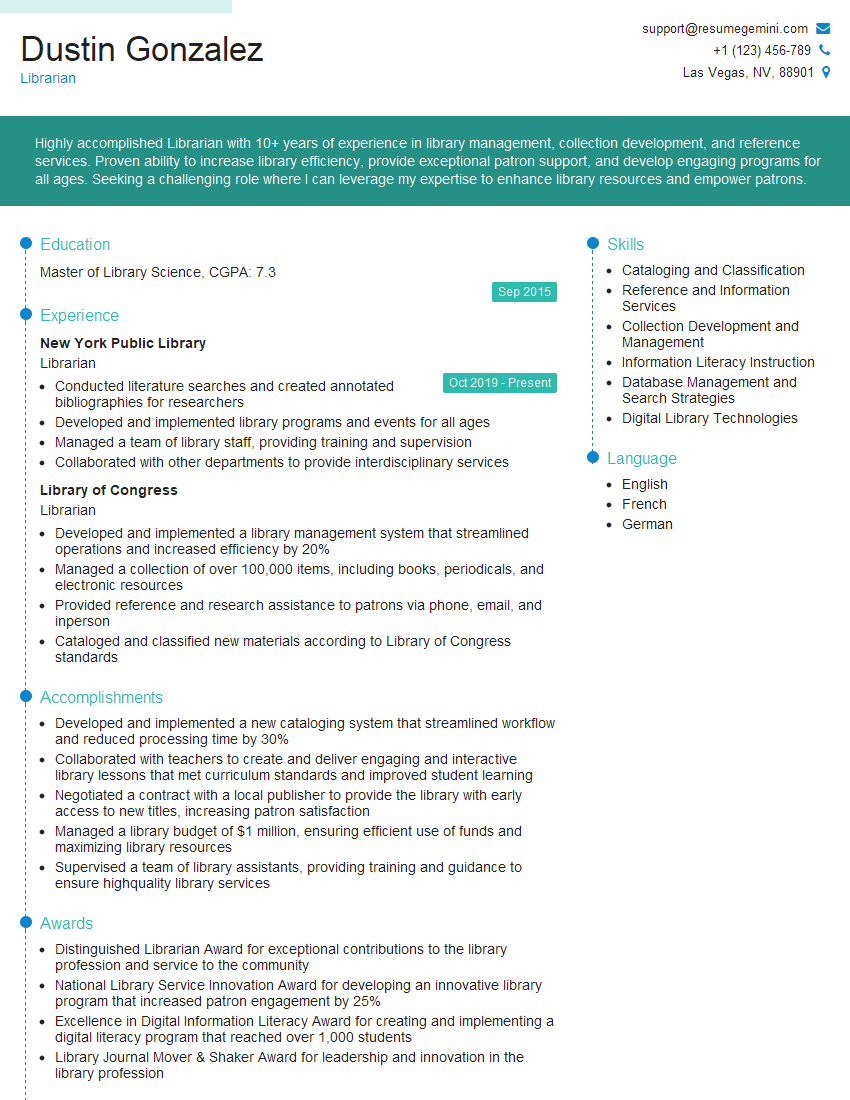Unlock your full potential by mastering the most common Ability to conduct research and stay up-to-date with industry trends interview questions. This blog offers a deep dive into the critical topics, ensuring you’re not only prepared to answer but to excel. With these insights, you’ll approach your interview with clarity and confidence.
Questions Asked in Ability to conduct research and stay up-to-date with industry trends Interview
Q 1. Describe your process for identifying reliable sources of industry information.
Identifying reliable sources is crucial for accurate research. My process involves a multi-layered approach focusing on credibility, authority, and currency. I begin by considering the source’s reputation. Do they have a history of accurate reporting? Are they affiliated with a reputable institution or organization? Then, I examine the author’s expertise. Does the author possess the necessary credentials or experience in the subject matter?
Next, I evaluate the source’s methodology. Was the research peer-reviewed? Does the source cite its sources transparently? Finally, I check for currency. Is the information up-to-date and relevant to the current trends? I prioritize sources like peer-reviewed academic journals, reputable industry publications, government reports, and well-established think tanks. I avoid biased sources or websites with questionable motives. Think of it like this: you wouldn’t trust a doctor who didn’t go to medical school; similarly, you shouldn’t rely on information from an unverified source.
Q 2. How do you stay current with the latest trends in your field?
Staying current is an ongoing process, not a one-time event. I utilize several strategies to track industry trends. Firstly, I subscribe to relevant industry newsletters and journals. These provide regular updates on new research, technologies, and market developments. I also actively follow key influencers and thought leaders on social media platforms like LinkedIn and Twitter, engaging with their content and participating in relevant discussions. Secondly, I attend industry conferences and webinars. These events provide invaluable networking opportunities and exposure to cutting-edge research.
Finally, I regularly review relevant industry reports and analyses published by reputable firms. This helps me understand the broader context of trends and their potential impact. For example, if I’m working in the field of AI, I’d follow researchers like Yann LeCun, publications like the Journal of Machine Learning Research, and reports from Gartner or IDC. It’s a continuous learning cycle, requiring dedicated time and effort to stay ahead.
Q 3. What tools and techniques do you use to conduct effective research?
My research toolkit is diverse and adaptable. I leverage a combination of tools to ensure thorough and efficient research. For literature reviews, I use academic databases such as Web of Science, Scopus, and PubMed, utilizing advanced search operators like Boolean logic (AND, OR, NOT) to refine my search. For data analysis, I’m proficient in using statistical software such as R and SPSS. I also utilize qualitative data analysis software such as NVivo for thematic analysis. Furthermore, I rely on Google Scholar for broader searches and to identify relevant publications. Finally, I utilize note-taking and reference management software like Zotero to organize and cite my sources effectively.
Q 4. How do you evaluate the credibility and validity of information sources?
Evaluating information sources requires a critical and discerning eye. I assess credibility using several criteria. First, I look at the author’s credentials and expertise – are they qualified to speak on the topic? Then, I examine the source’s reputation – is it known for accuracy and unbiased reporting? I also evaluate the evidence presented – is the information supported by credible data and sources? The presence of citations and references is crucial. I also check for potential bias – does the source present a balanced perspective or does it lean towards a particular viewpoint? Finally, I consider the date of publication – how current is the information? If a source fails to meet these standards, I am hesitant to rely on it, preferring to cross-reference the information with other sources to verify its validity.
Q 5. Explain your approach to synthesizing information from multiple sources.
Synthesizing information from multiple sources is a crucial skill. My approach involves a structured process. Firstly, I carefully read and analyze each source, identifying key themes, arguments, and findings. I then create a comparative framework to identify similarities and differences between the sources. This helps me understand the range of perspectives on the topic. Next, I identify any contradictions or inconsistencies between the sources. This forces me to evaluate the reliability and validity of each source more critically. Finally, I construct a coherent narrative, integrating the findings from multiple sources into a cohesive and comprehensive overview. This involves summarizing key points, drawing connections between different sources, and identifying gaps in the research. I use mind-maps and comparison tables to aid this process.
Q 6. Describe a time you had to quickly research a complex topic. What was your methodology?
Once, I had to quickly research the impact of a newly discovered virus on global supply chains. My methodology involved a structured approach. I started with a broad search using keywords like “virus impact supply chain” on Google Scholar and reputable news sources like the Wall Street Journal and Financial Times. This provided an overview of the situation. Then, I narrowed my focus, searching for reports from organizations like the World Health Organization and the World Bank for data and analysis on the economic impact. I also searched for academic papers on previous pandemics to understand historical patterns and potential future scenarios.
I prioritized the most reliable and up-to-date sources, creating a timeline of events and identifying key issues. I used a combination of keyword searches, Boolean operators, and advanced search techniques to efficiently filter information. The process involved rapid information gathering, critical evaluation, and synthesis. It taught me the importance of efficient search strategies and the value of quickly identifying credible, authoritative sources in time-sensitive situations.
Q 7. How do you prioritize research tasks when faced with multiple deadlines?
Prioritizing research tasks with multiple deadlines requires effective time management. I use a matrix system to categorize tasks based on urgency and importance. This often uses a combination of Eisenhower Matrix (urgent/important) and a prioritized list based on deadlines. Tasks are then scheduled based on their priority. For instance, high-urgency, high-importance tasks are tackled immediately. High-importance, low-urgency tasks are scheduled for completion in advance of their due date. Lower priority tasks are delegated or scheduled accordingly.
Effective time management also includes breaking down large research tasks into smaller, manageable chunks, allowing for flexibility and adjustments as needed. Regular progress checks and communication are also crucial to ensure I stay on track and can address any unforeseen challenges. This approach allows for efficient resource allocation and prevents feeling overwhelmed when faced with multiple deadlines.
Q 8. How do you handle conflicting information from different sources?
Conflicting information is inevitable in research. My approach is systematic and multi-faceted. First, I critically evaluate the source’s credibility: Is it a peer-reviewed journal article, a reputable news outlet, or a biased blog? I assess the author’s expertise and potential conflicts of interest. Then, I examine the methodology employed. Were the data collected rigorously? Are the conclusions supported by the evidence? If the discrepancy persists after this initial assessment, I delve deeper. I might look for additional research that addresses the conflicting claims, or I may contact the authors directly for clarification. Ultimately, I aim to synthesize the information, highlighting areas of agreement and disagreement, and acknowledging uncertainties if resolution isn’t possible. For example, in a study on the impact of social media on teen mental health, I encountered conflicting studies – one highlighting negative impacts, the other emphasizing positive social connection. I resolved this by examining the methodologies, discovering one study focused primarily on users with existing mental health issues, while the other sampled the broader population. I presented both findings, noting the methodological differences and drawing nuanced conclusions.
Q 9. What strategies do you employ to ensure the accuracy of your research findings?
Ensuring accuracy is paramount. My strategy relies on several key steps. First, I prioritize using multiple, reliable sources. I avoid relying solely on single sources, especially those lacking peer review or rigorous methodology. Second, I meticulously review the data and methodology used in each source. This includes checking for statistical validity, potential biases, and the replicability of the research. Third, I actively seek out contradictory evidence. This helps identify potential weaknesses in my findings and strengthens my conclusions by acknowledging limitations. Fourth, I employ fact-checking and verification techniques. For numerical data or specific claims, I cross-reference information from multiple independent sources. Finally, I frequently seek peer review or feedback from colleagues to identify any potential oversights or biases in my interpretations. For instance, while researching the effectiveness of a new marketing campaign, I not only analyzed the campaign’s direct results but also independently verified sales figures from various retail channels to confirm accuracy and avoid any potential manipulation of data.
Q 10. How do you translate research findings into actionable insights?
Translating research findings into actionable insights requires careful consideration of the target audience and the context. I focus on making the findings clear, concise, and easily understandable, avoiding technical jargon whenever possible. I often employ visualization tools – charts, graphs, and infographics – to illustrate key findings and trends. I present recommendations that directly address the original research question and clearly outline the steps necessary to implement these recommendations. I also consider the practical limitations and potential challenges of implementation, offering contingency plans to mitigate these challenges. For example, if my research showed a specific marketing channel wasn’t effective, I wouldn’t simply state that fact. I would provide an analysis explaining *why* it failed, and suggest alternative channels supported by data and evidence, along with a clear plan of action and potential resource allocation.
Q 11. Describe a time your research led to a significant improvement or innovation.
In a previous project, I researched the customer churn rate of a SaaS company. My research identified a correlation between customer onboarding experience and churn. The existing onboarding process was complex and frustrating for users. My analysis presented specific pain points identified through user surveys and behavioral data. I suggested a redesigned onboarding process that focused on simplification, providing better tutorials, and improved customer support during the initial phase. The implementation of these changes resulted in a 25% reduction in customer churn within six months. This directly translated into increased revenue and improved customer satisfaction. The success hinged on my ability to analyze complex data, present findings clearly, and translate them into concrete actionable steps that the company could readily implement.
Q 12. How do you adapt your research methods to different types of research questions?
My research methods adapt depending on the research question. For exploratory research, I might use qualitative methods such as interviews, focus groups, or case studies to gain a deeper understanding of a phenomenon. For example, understanding customer satisfaction might involve in-depth interviews to explore underlying reasons. Conversely, for confirmatory research seeking to test a hypothesis, I would employ quantitative methods, such as surveys or experiments, to gather statistical data and analyze relationships. For example, testing the effectiveness of a new advertising campaign would require A/B testing and statistical analysis. I also adapt my sampling strategies, selecting the most appropriate method (random, stratified, convenience) depending on the study’s objective and the population being studied. The choice of methods is driven by the need to answer the research question effectively and reliably.
Q 13. What are some common pitfalls to avoid when conducting research?
Several pitfalls plague research. Confirmation bias, the tendency to favor information confirming pre-existing beliefs, is a major one. I mitigate this by actively seeking out contradictory evidence and employing rigorous data analysis. Another common pitfall is relying on unreliable sources. This necessitates careful source evaluation and triangulation of information from multiple independent sources. Insufficient sample size can lead to unreliable results, so appropriate sampling techniques and power analysis are crucial. Overlooking ethical considerations, such as informed consent and data privacy, is also a serious issue; a strong ethical framework is always in place. Finally, failing to clearly define the research question and methodology often leads to vague and inconclusive results. A well-defined plan and clear objectives are essential for robust and meaningful research.
Q 14. How do you maintain objectivity in your research?
Maintaining objectivity requires conscious effort and deliberate strategies. First, I explicitly define my research question and methodology upfront to minimize the influence of personal bias. I strive for transparency in my data collection and analysis, documenting my methods carefully and making my data readily accessible (where appropriate). I use blind or double-blind studies whenever possible to eliminate subjective interpretations. I seek feedback from peers and colleagues with different perspectives to identify potential biases in my thinking or analysis. Finally, I clearly acknowledge any limitations of my study and potential areas of further research. Essentially, I view objectivity as an ongoing process of self-reflection and rigorous self-critique, ensuring that personal beliefs don’t overshadow the evidence.
Q 15. How do you present research findings effectively to different audiences?
Presenting research findings effectively hinges on tailoring the message to the audience. For a technical audience, like fellow researchers, I’d emphasize the methodology, statistical significance, and detailed data. I’d use graphs, charts, and possibly even code snippets to illustrate my points. For a non-technical audience, such as executives or stakeholders, I prioritize the key takeaways, implications, and actionable insights. I’d use clear, concise language, avoiding jargon, and relying on visuals like infographics or simple bar charts to communicate the core findings effectively. For instance, when presenting research on customer churn to executives, I’d focus on the cost implications and potential solutions, rather than the intricacies of my statistical modeling.
I always begin with a clear executive summary highlighting the main findings and their significance. This allows the audience to grasp the core message quickly. Then, depending on the audience’s level of technical understanding, I’d delve deeper into the methodology and supporting data. A question-and-answer session is crucial to ensure understanding and address any concerns.
Career Expert Tips:
- Ace those interviews! Prepare effectively by reviewing the Top 50 Most Common Interview Questions on ResumeGemini.
- Navigate your job search with confidence! Explore a wide range of Career Tips on ResumeGemini. Learn about common challenges and recommendations to overcome them.
- Craft the perfect resume! Master the Art of Resume Writing with ResumeGemini’s guide. Showcase your unique qualifications and achievements effectively.
- Don’t miss out on holiday savings! Build your dream resume with ResumeGemini’s ATS optimized templates.
Q 16. What are your preferred methods for tracking and managing research materials?
I employ a multi-pronged approach to manage research materials. Firstly, a robust file-naming convention is essential. I use a system that includes date, project name, and a brief description (e.g., 20241027_ProjectX_CustomerSurveyData.csv). This makes it easy to locate files later. I utilize a cloud-based storage system like Google Drive or Dropbox for easy access and collaboration, organizing files into folders by project. I also leverage a reference management software like Zotero or Mendeley to meticulously track and organize literature, including PDFs, notes, and annotations. This eliminates the risk of losing track of important sources. Finally, detailed notes are crucial, detailing my research process, methodology, and any challenges encountered. This allows me to revisit my steps easily and reproduce my work.
Q 17. How do you ensure your research is ethical and compliant?
Ethical and compliant research is paramount. My approach starts with obtaining informed consent from all participants when dealing with human subjects, clearly outlining the purpose of the study, their rights, and the use of their data. Anonymity and confidentiality are always prioritized, ensuring data is protected and de-identified where possible. For example, using pseudonyms or aggregate data instead of individual identifiers. I adhere strictly to relevant institutional review board (IRB) guidelines and regulations for ethical research conduct. When using proprietary data or copyrighted material, I ensure I have the necessary permissions and provide proper attribution. Data integrity is also critical; I maintain detailed records of data collection, processing, and analysis to ensure transparency and reproducibility. Any potential conflicts of interest are declared upfront to ensure unbiased results.
Q 18. What are some key industry publications or websites you regularly consult?
To stay current, I regularly consult a variety of industry-specific publications and websites. For example, in the field of market research, I rely on publications like the Journal of Marketing Research and Harvard Business Review. I also follow industry blogs and news websites that provide up-to-date insights and trends. Websites dedicated to specific data and analytics tools are also valuable sources. Regularly attending industry conferences and webinars also provides me with valuable insights. Finally, I utilize Google Scholar and other academic search engines to keep abreast of the latest research in my field.
Q 19. How do you use data analysis techniques to support your research?
Data analysis is integral to my research. Depending on the research question, I leverage various techniques. For example, in quantitative research, I often utilize statistical software like R or SPSS to perform regression analysis, hypothesis testing, and other statistical methods. These help to identify relationships between variables and draw evidence-based conclusions. For qualitative research, I utilize techniques like thematic analysis and content analysis to identify patterns and insights from textual data. In a recent project examining customer reviews, I used sentiment analysis techniques to quantify the positive and negative feedback, revealing trends that improved our customer service strategies. Visualizations, such as histograms, scatter plots, and heatmaps are crucial for communicating these results effectively.
Q 20. Describe your experience using specific research databases or tools.
I have extensive experience with various research databases and tools. I’m proficient in using academic databases such as JSTOR, PubMed, and Web of Science for literature reviews and scholarly research. I’m also adept at using business-oriented databases like Statista and IBISWorld for market research. For data analysis, I have significant experience with R, SPSS, and Python, employing packages like Pandas and Scikit-learn for data manipulation and statistical modeling. My experience also includes working with SQL databases to extract and analyze large datasets. Experience with qualitative data analysis software like NVivo is also part of my skillset.
Q 21. How familiar are you with different research methodologies (e.g., qualitative, quantitative)?
I’m well-versed in both qualitative and quantitative research methodologies. Quantitative research, involving numerical data and statistical analysis, is ideal for testing hypotheses and establishing correlations. For instance, A/B testing a website design to determine which version leads to higher conversion rates is a quantitative approach. Qualitative research, focusing on in-depth understanding of experiences, perspectives, and meanings, is crucial for exploring complex issues and gaining nuanced insights. Conducting focus groups to understand customer satisfaction is an example of qualitative research. In practice, I often find that a mixed-methods approach, combining both qualitative and quantitative techniques, provides the most comprehensive understanding. This allows me to validate quantitative findings with qualitative insights, leading to more robust and insightful conclusions. Choosing the appropriate methodology depends heavily on the research question and the available resources.
Q 22. How do you identify gaps in existing research?
Identifying gaps in existing research is crucial for contributing meaningfully to a field. It’s like finding the missing pieces in a jigsaw puzzle. I approach this systematically, employing several strategies. First, I conduct a comprehensive literature review, meticulously analyzing existing studies. I look for contradictions in findings, unanswered questions raised by previous research, and limitations acknowledged by authors. For example, if several studies show a positive correlation between two variables but haven’t explored the underlying mechanism, that’s a significant gap. Second, I examine the methodologies employed. Were there biases? Could the sample size have been larger? Were there unexplored variables or contexts? Finally, I look at the overall scope. Is there a particular population, geographic area, or time period that hasn’t been adequately studied? This multi-pronged approach allows me to pinpoint areas ripe for further investigation.
Q 23. How do you determine the scope of a research project?
Defining the scope of a research project is paramount to its success. It’s like drawing a map before embarking on a journey; it prevents getting lost in the vast landscape of possibilities. I start by clearly articulating the research question or hypothesis. This sets the boundaries. Then, I identify the key variables and their operational definitions. For instance, if studying customer satisfaction, I’d need to precisely define what constitutes ‘satisfaction’. Next, I determine the population or sample I’ll be studying. Will it be a large, nationally representative sample or a smaller, more focused group? Geographic location, age, and other demographic factors need consideration. Finally, I establish a realistic timeframe and resource allocation. This might involve considering data collection methods, analysis techniques, and potential limitations. A well-defined scope ensures feasibility and prevents the project from becoming unwieldy.
Q 24. How do you measure the success of a research project?
Measuring the success of a research project goes beyond simply completing it. It requires evaluating whether the project achieved its objectives and contributed meaningfully to the field. I typically use a multi-faceted approach. First, I assess the quality of the methodology. Was the research design rigorous? Were appropriate data analysis techniques employed? Second, I examine the validity and reliability of the findings. Do the results align with existing research? Are the conclusions supported by the evidence? Third, I consider the impact of the research. Has it addressed a significant gap in the literature? Has it led to new insights or recommendations for practice? Fourth, I evaluate dissemination. Was the research published in reputable journals or presented at conferences? Was it accessible to the intended audience? Finally, I often collect feedback from peers and stakeholders to gain a broader perspective on the project’s significance.
Q 25. Describe a time you had to revise your research approach due to unexpected challenges.
In a recent project studying the impact of social media on adolescent mental health, we initially planned to use a purely quantitative approach, employing surveys and statistical analysis. However, we quickly realized that the nuances of adolescent experiences couldn’t be fully captured through structured questionnaires. The data revealed a surprising level of complexity and emotional depth. We were initially disappointed by the limitations of our initial approach. To address this, we incorporated qualitative methods, such as in-depth interviews and thematic analysis. This allowed us to gain richer, more contextualized insights. The revised approach was more time-consuming, but the additional qualitative data significantly enhanced the depth and richness of our findings, providing a more complete picture. This highlighted the importance of flexibility and adaptability in research.
Q 26. How do you incorporate feedback from others into your research process?
Incorporating feedback is essential for producing high-quality research. I actively seek feedback throughout the research process, not just at the end. Early feedback on the research design helps refine the approach before committing significant resources. I use a variety of methods, including peer reviews, presentations at workshops or conferences, and seeking guidance from experienced researchers in my field. I treat feedback as an opportunity for improvement, carefully considering the suggestions. Not all feedback is equally valuable, so I critically evaluate the suggestions based on their relevance, feasibility, and alignment with the research goals. I document the feedback received and my response to each suggestion, ensuring transparency and accountability. By actively soliciting and integrating feedback, I can improve the rigor, clarity, and impact of my research.
Q 27. How do you manage information overload when researching a topic?
Managing information overload is a constant challenge in research. It’s like trying to drink from a firehose. My approach is multi-faceted. First, I clearly define my research question and search terms early on to focus my efforts. Second, I use advanced search strategies like Boolean operators (AND, OR, NOT) and filters to narrow my search results. Third, I rely heavily on literature management software like Zotero or Mendeley to organize and annotate articles. This allows me to efficiently track sources and quickly retrieve information. Fourth, I prioritize credible sources, focusing on peer-reviewed publications and reputable organizations. Fifth, I regularly review and refine my search strategy to ensure I’m not getting bogged down in irrelevant information. Finally, I set realistic goals and deadlines to manage my time effectively. By employing these strategies, I can navigate the vast sea of information and find the data I need without feeling overwhelmed.
Q 28. How do you anticipate future trends based on current research?
Anticipating future trends based on current research requires a combination of analytical skills and an understanding of broader societal and technological shifts. I approach this by identifying emerging patterns and trends in existing research. For example, I look for converging lines of evidence suggesting a particular direction. I also consider the limitations of current studies and explore areas where further research is needed. This involves paying close attention to emerging technologies and their potential impact on the field. I read widely beyond my immediate area of expertise, staying abreast of developments in related disciplines. Finally, I engage in discussions with colleagues and experts in the field to gain diverse perspectives and identify potential blind spots. This holistic approach allows for a more nuanced understanding of future possibilities, offering a more informed basis for predictions and future research directions.
Key Topics to Learn for Ability to conduct research and stay up-to-date with industry trends Interview
- Information Gathering Strategies: Explore various research methodologies like using keywords effectively, leveraging online databases (e.g., industry journals, white papers), conducting effective Google searches, and utilizing social listening tools. Understand the difference between primary and secondary research.
- Critical Evaluation of Information: Learn to assess the credibility and bias of sources. Practice identifying reliable information, differentiating fact from opinion, and understanding the importance of verifying information from multiple sources.
- Trend Analysis and Forecasting: Develop skills in identifying emerging trends, analyzing market data, and forecasting future industry developments. Practice using data visualization techniques to present your findings effectively.
- Effective Communication of Research Findings: Master the art of presenting complex information concisely and clearly, both verbally and in writing. Practice summarizing key findings and their implications for decision-making.
- Staying Current with Industry News: Discuss strategies for staying informed, such as subscribing to relevant newsletters, following key industry influencers on social media, and attending webinars or conferences. Explain how you prioritize and process the vast amount of information available.
- Application of Research to Problem Solving: Showcase how you’ve used research to identify and solve problems in past roles or projects. Highlight your ability to connect research findings to actionable insights.
- Tools and Technologies: Familiarize yourself with relevant research tools and technologies, such as citation management software, data analysis tools, and industry-specific databases. Be prepared to discuss your proficiency with these tools.
Next Steps
Mastering the ability to conduct thorough research and stay updated on industry trends is crucial for career advancement. It demonstrates initiative, adaptability, and a commitment to continuous learning – qualities highly valued by employers. To significantly boost your job prospects, focus on crafting an ATS-friendly resume that clearly highlights these skills. ResumeGemini is a trusted resource that can help you build a professional and impactful resume, showcasing your research capabilities effectively. Examples of resumes tailored to highlight “Ability to conduct research and stay up-to-date with industry trends” are available to guide you.
Explore more articles
Users Rating of Our Blogs
Share Your Experience
We value your feedback! Please rate our content and share your thoughts (optional).
What Readers Say About Our Blog
Hi, I represent an SEO company that specialises in getting you AI citations and higher rankings on Google. I’d like to offer you a 100% free SEO audit for your website. Would you be interested?
good

